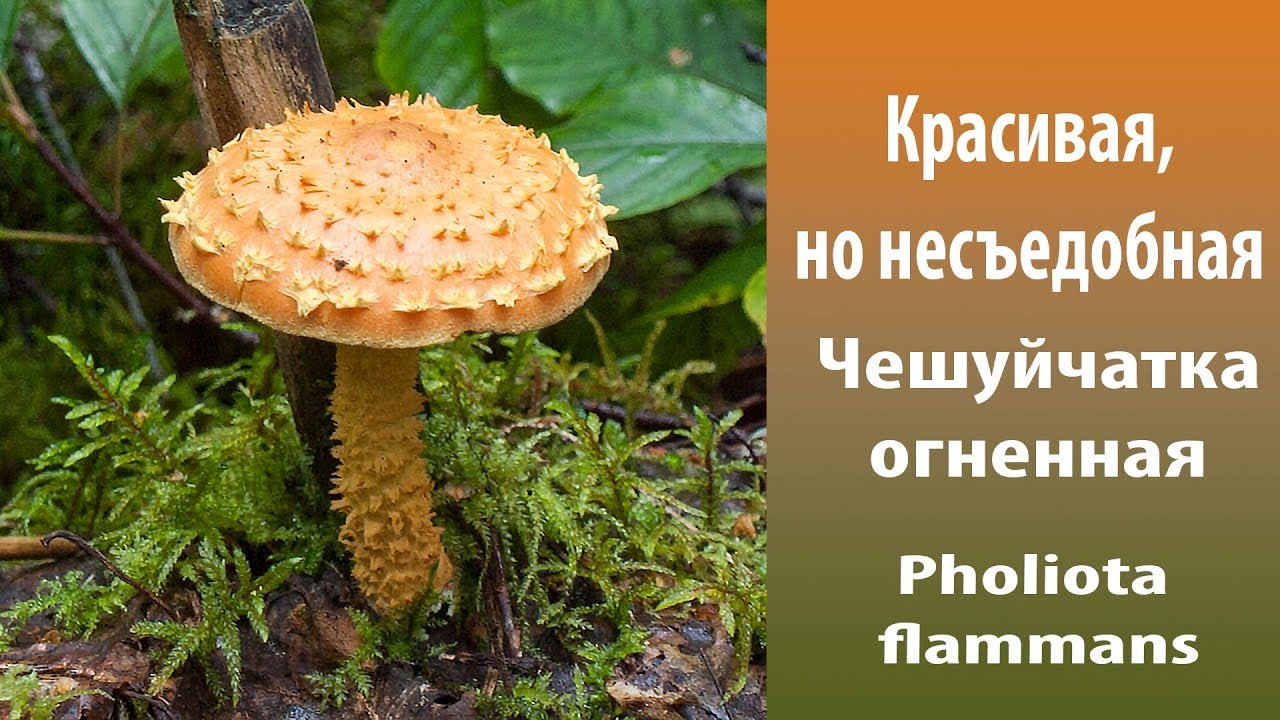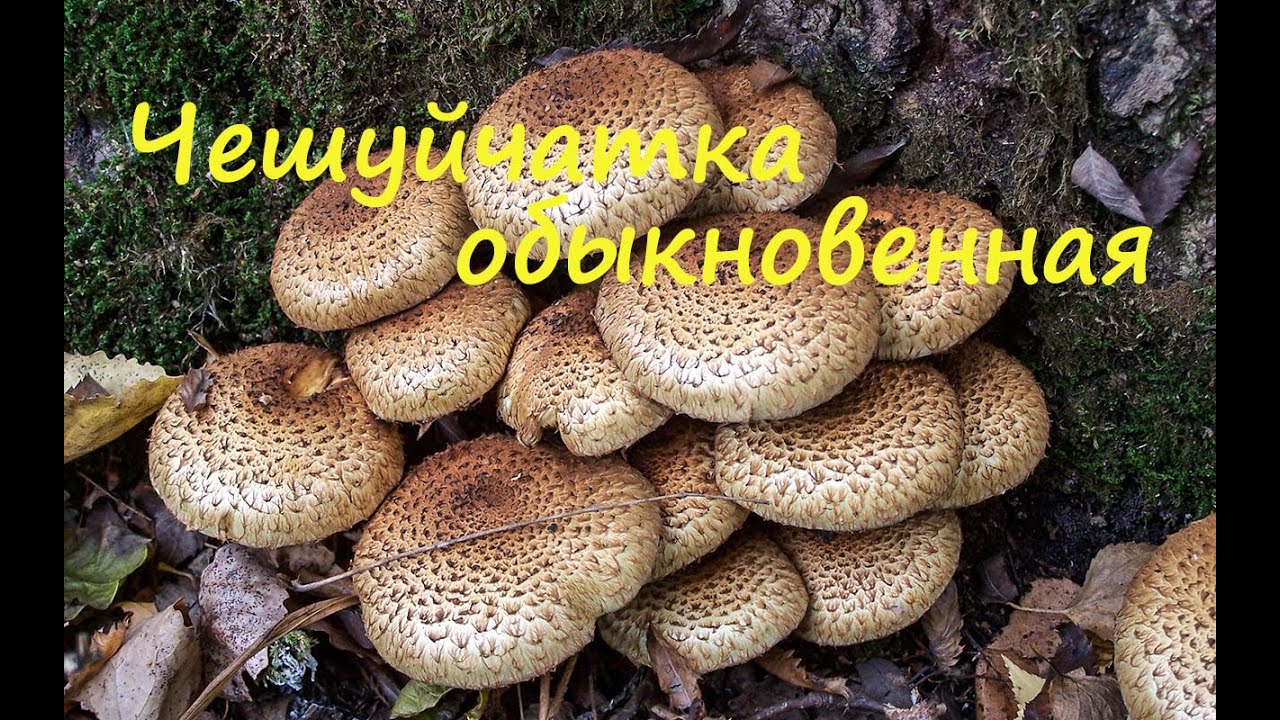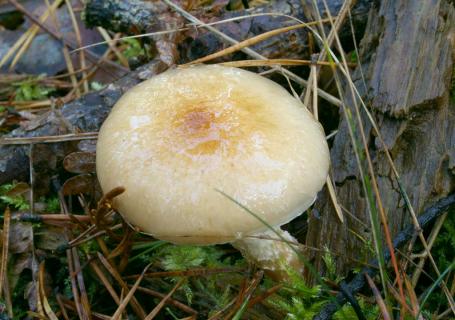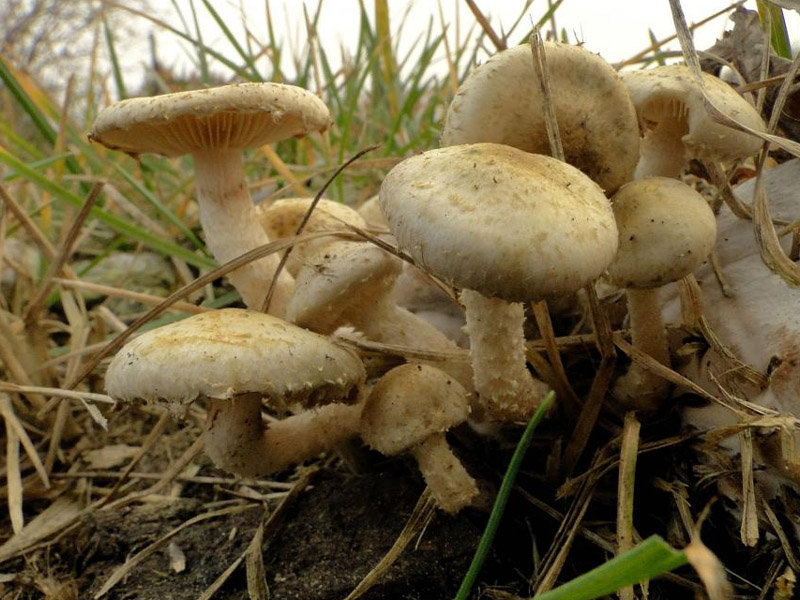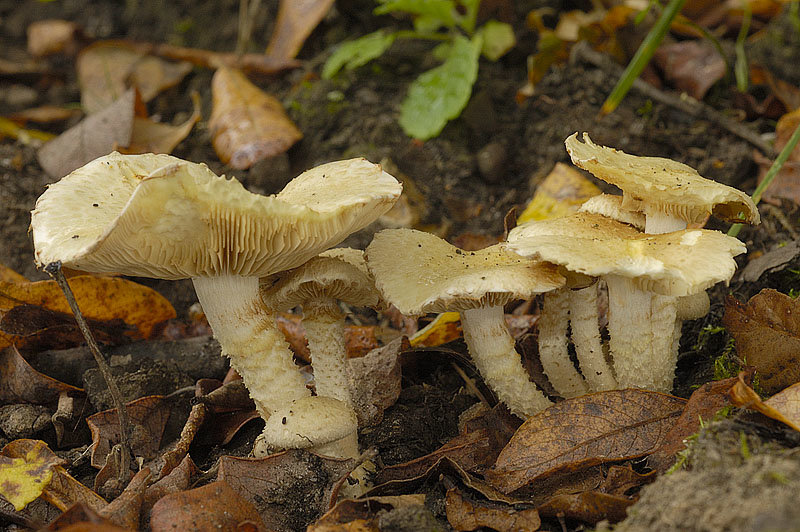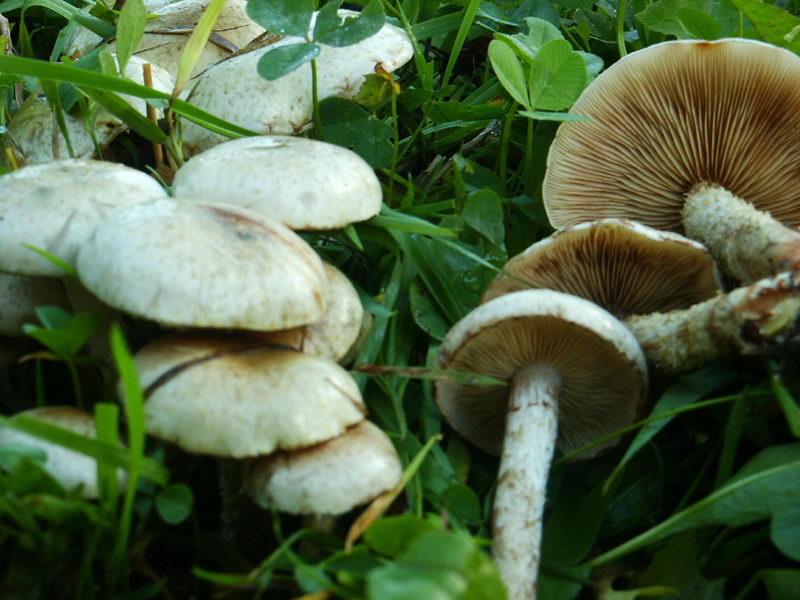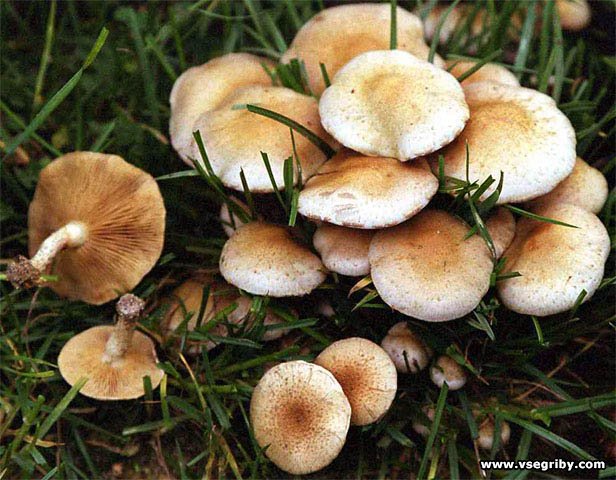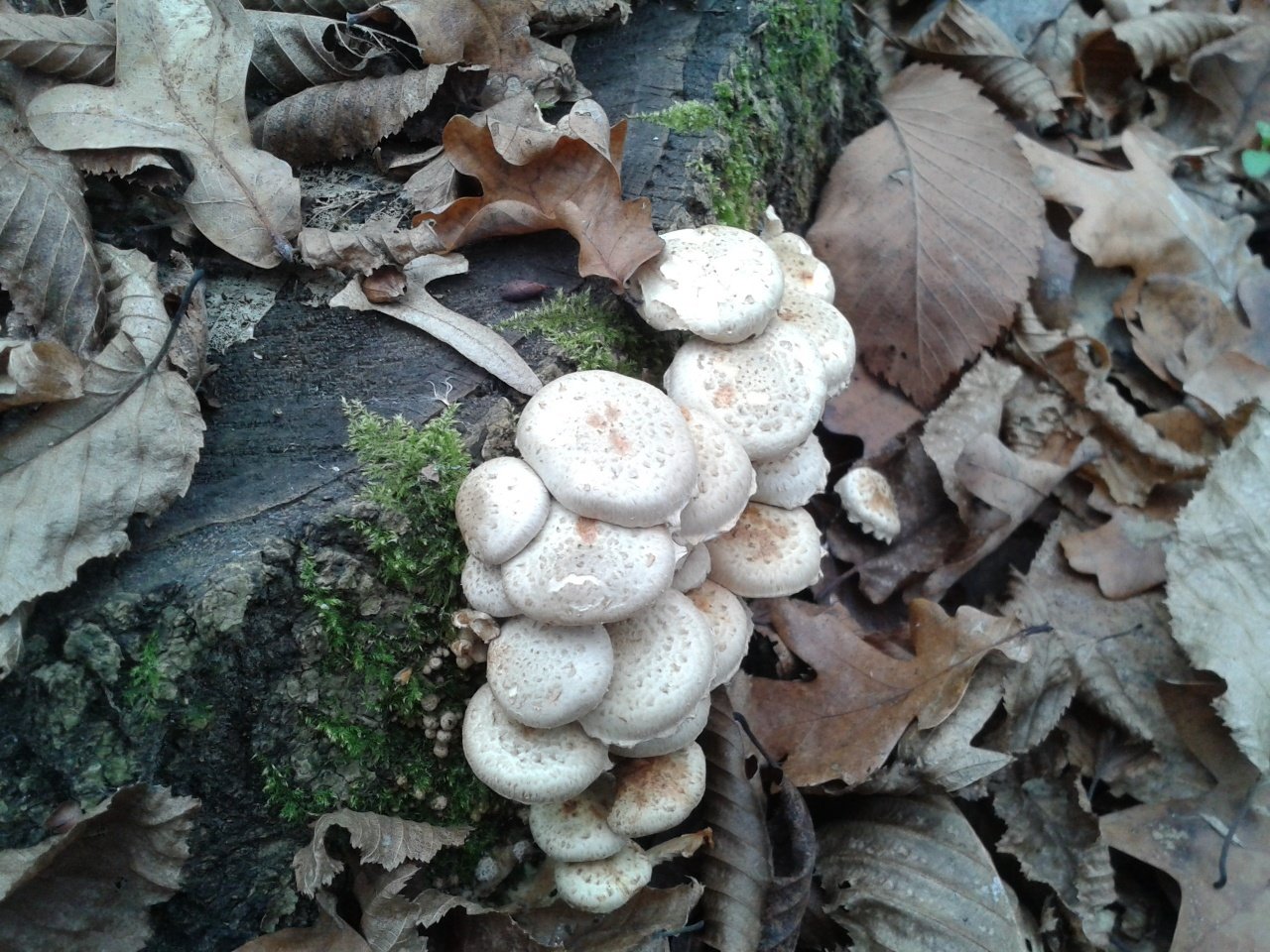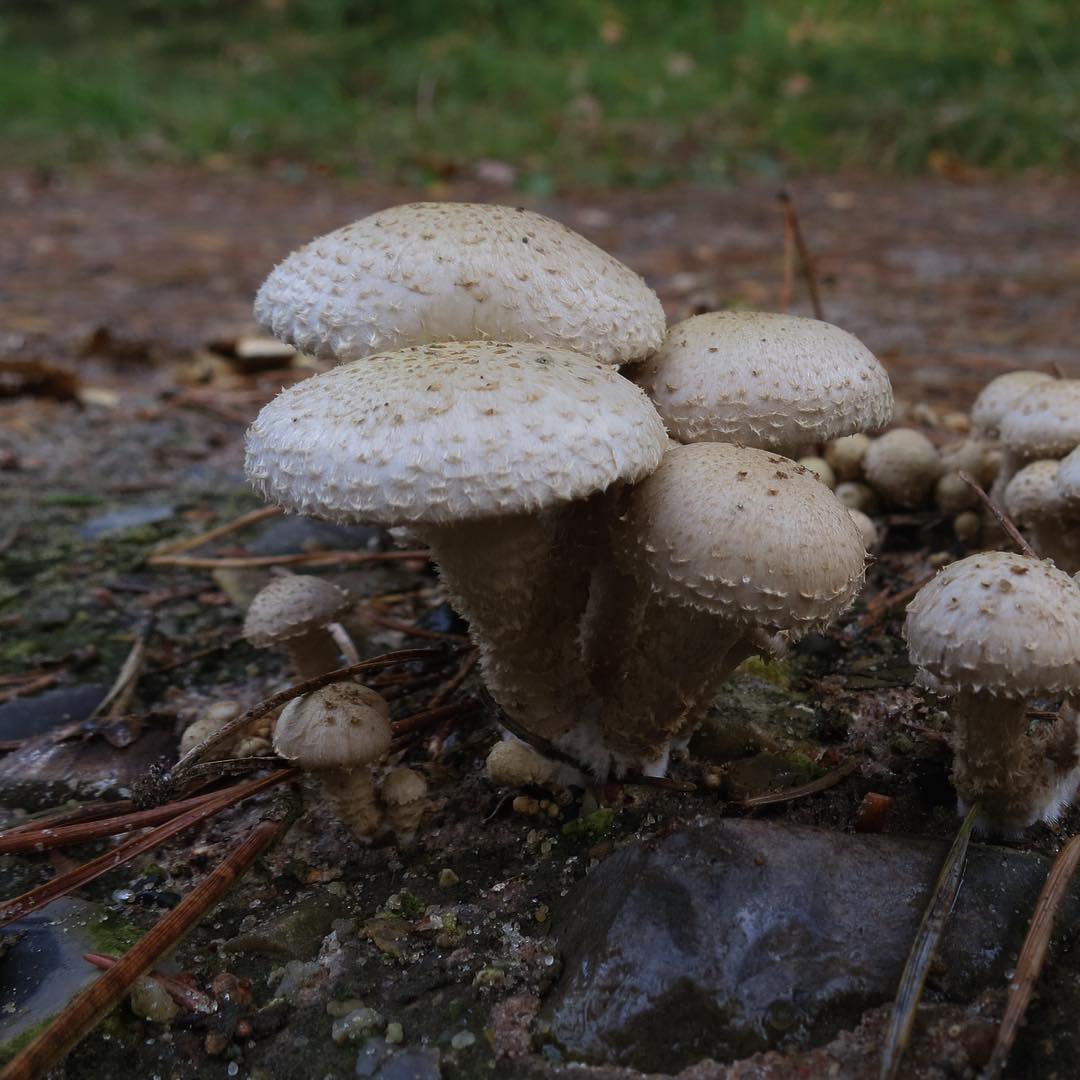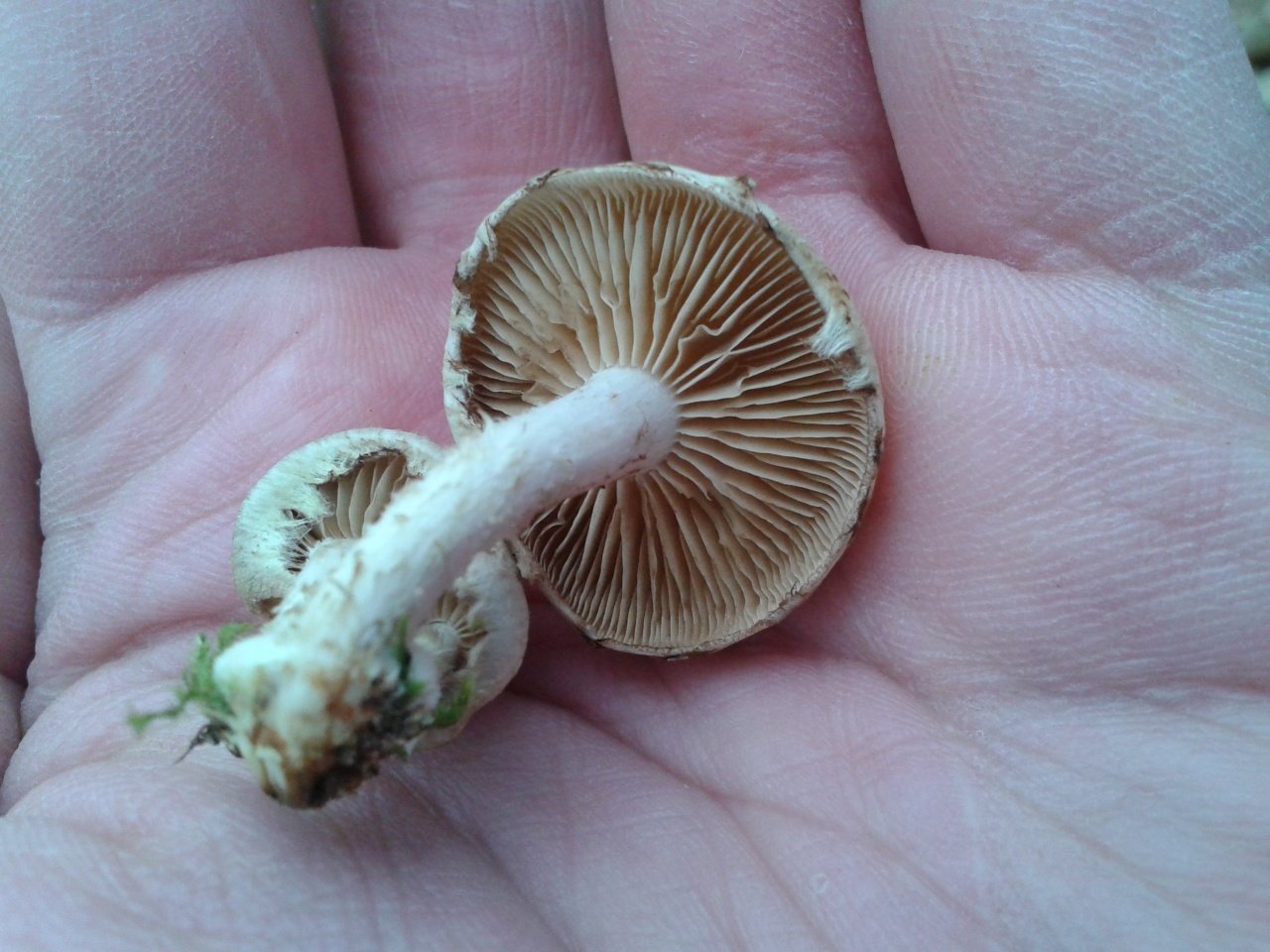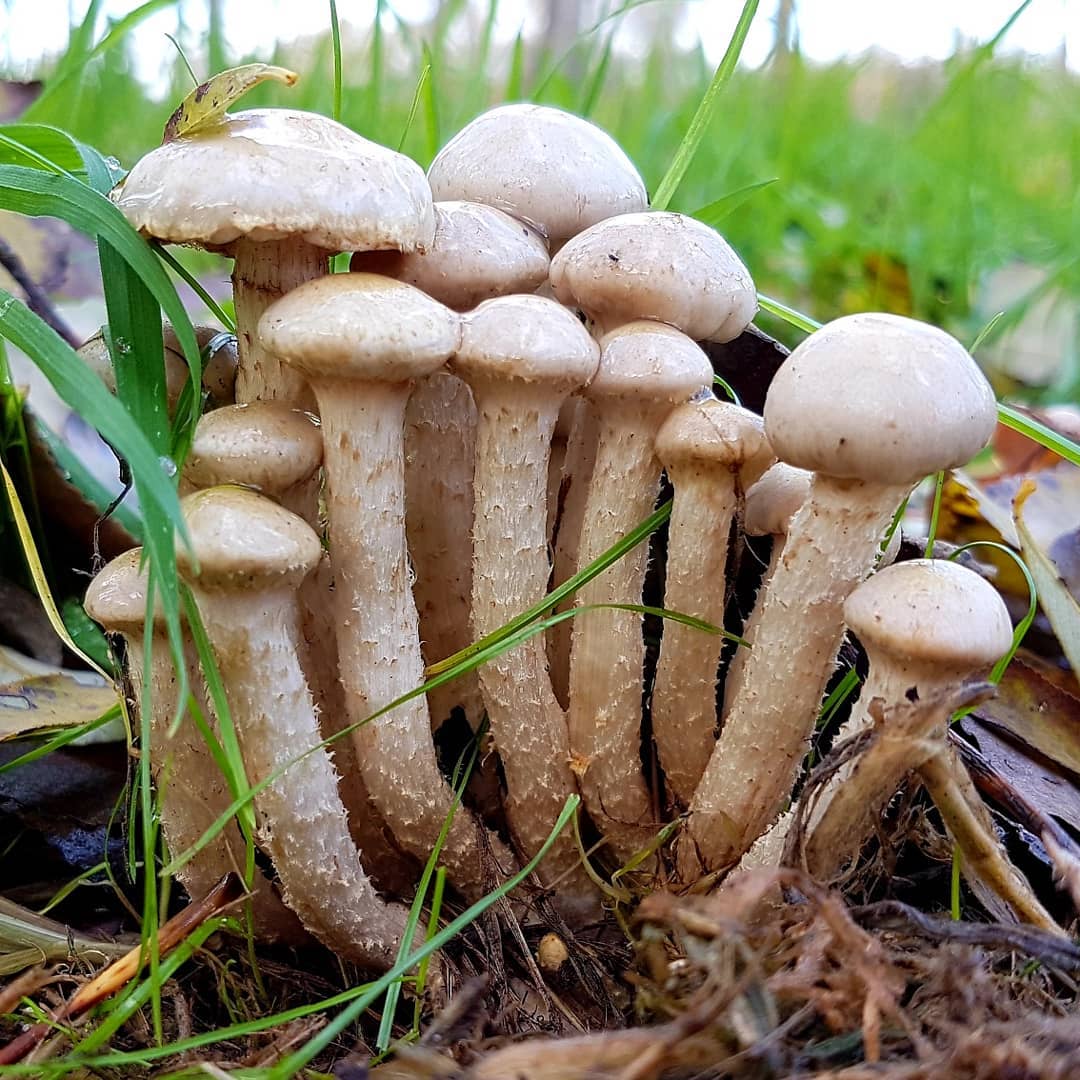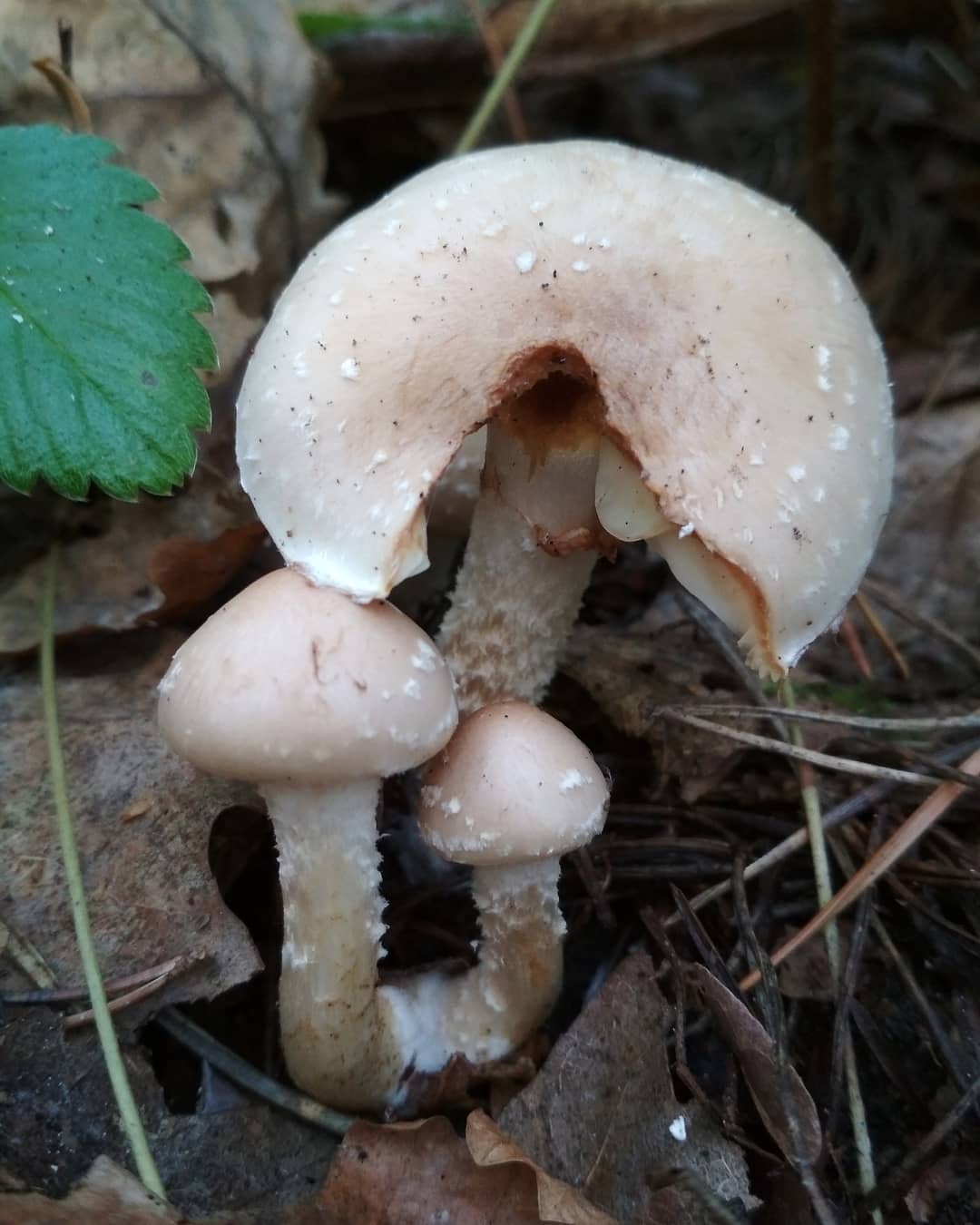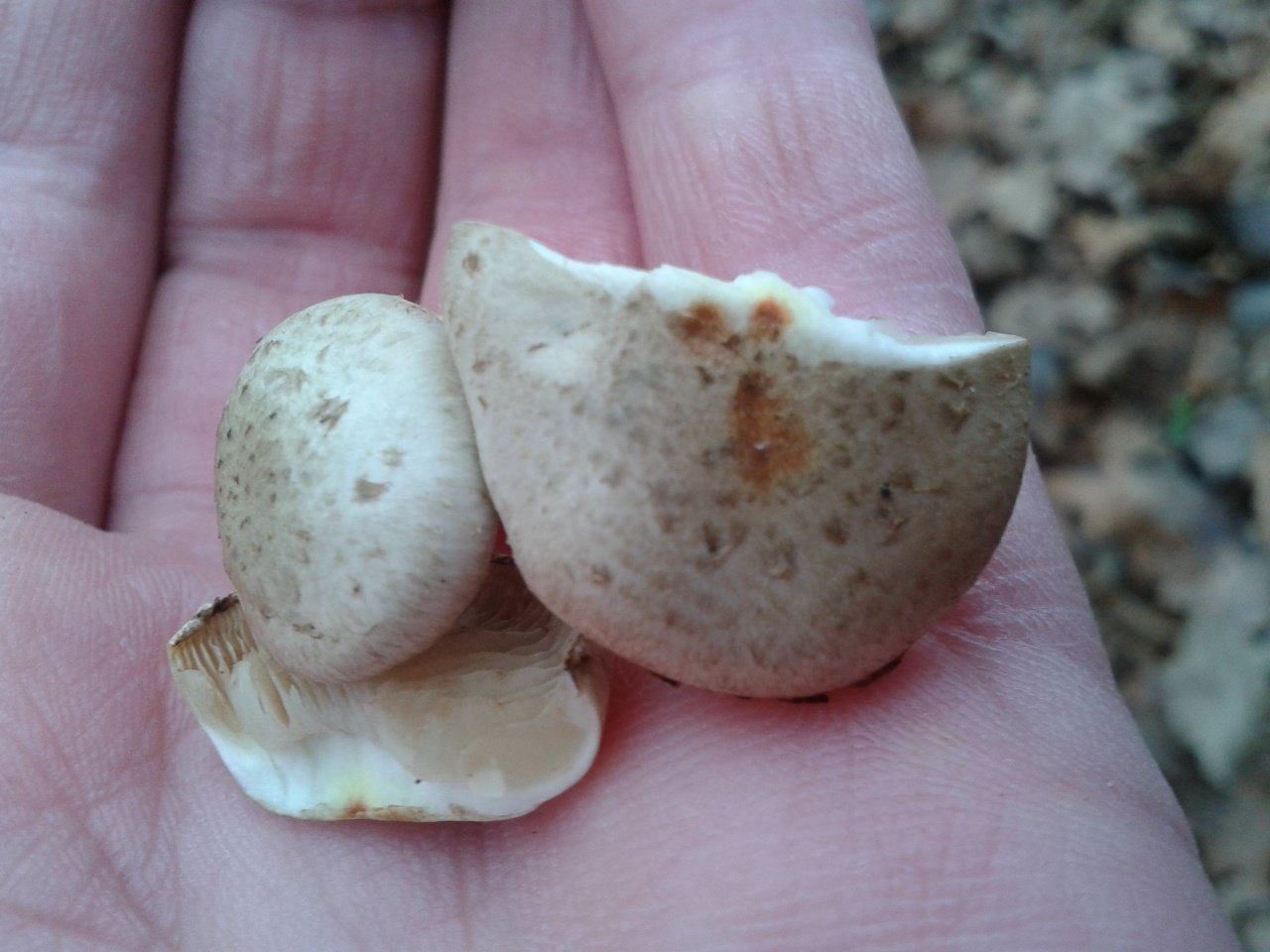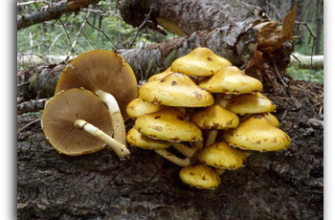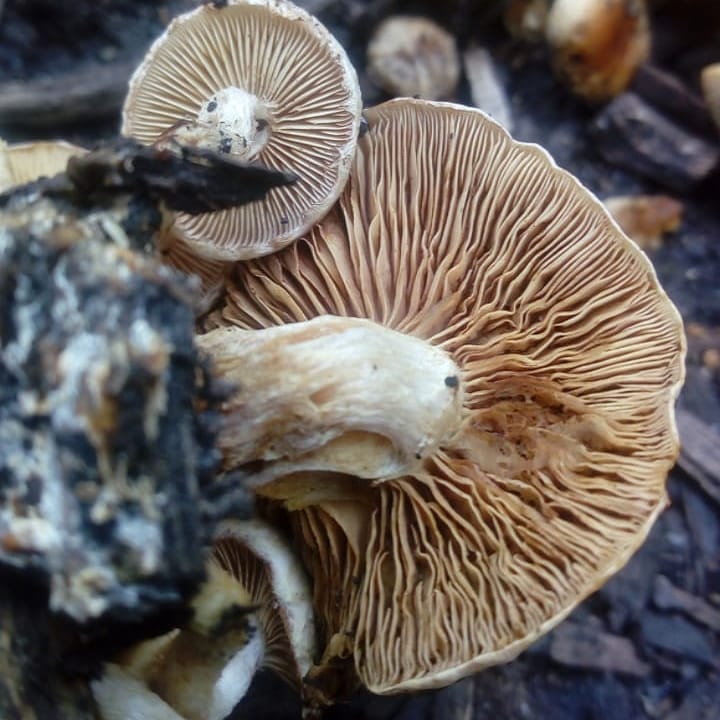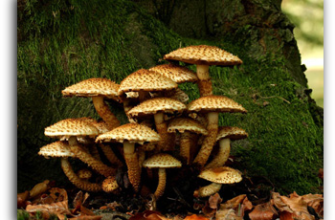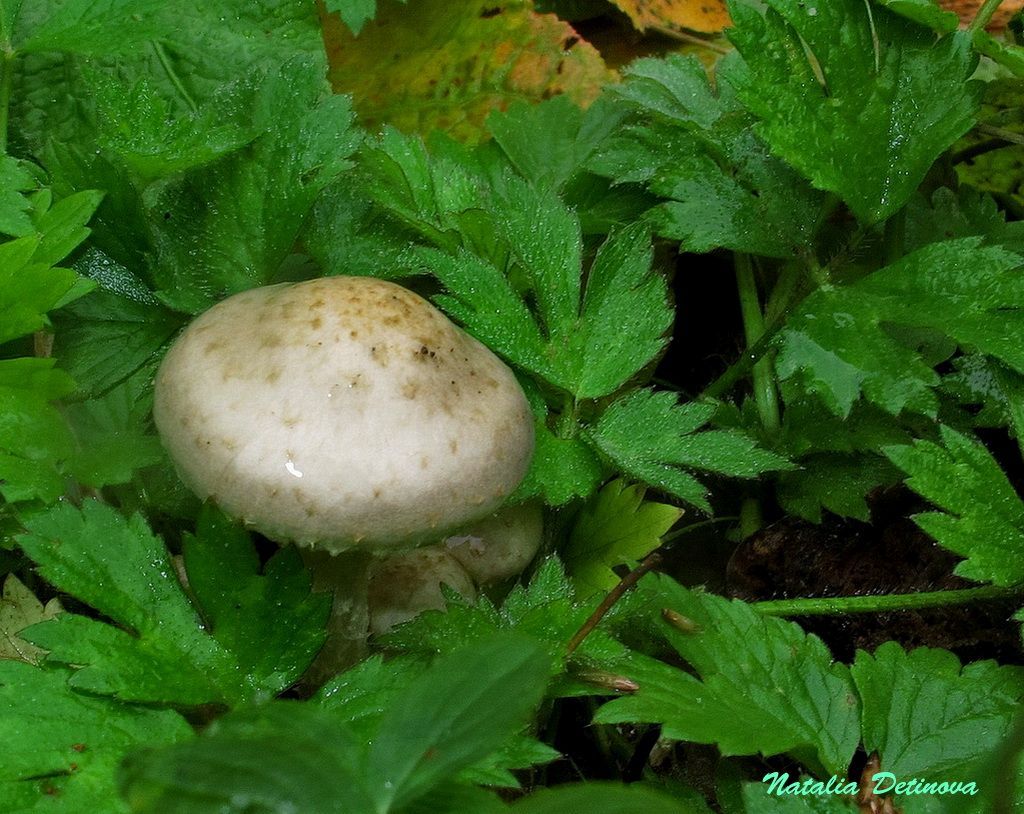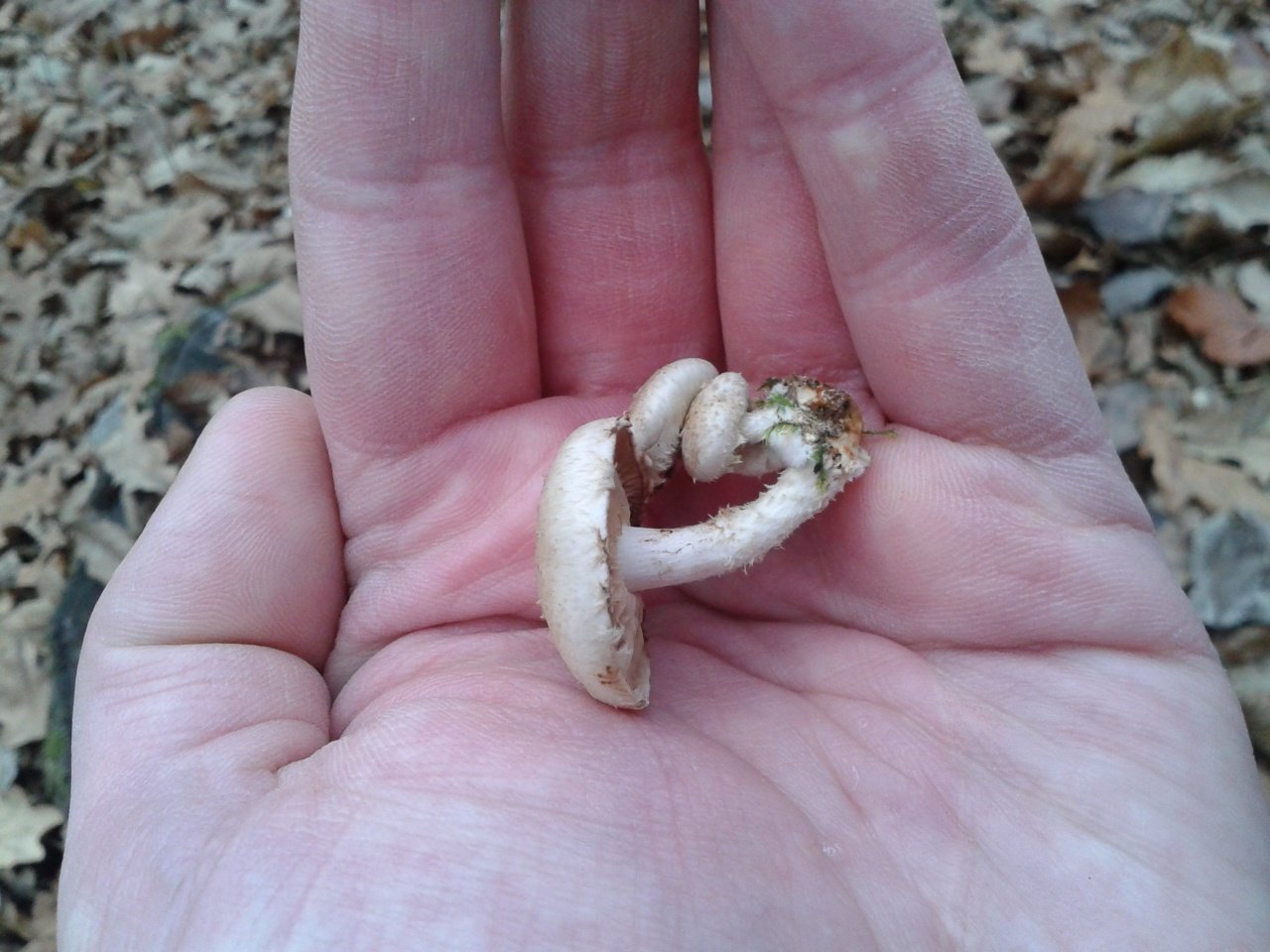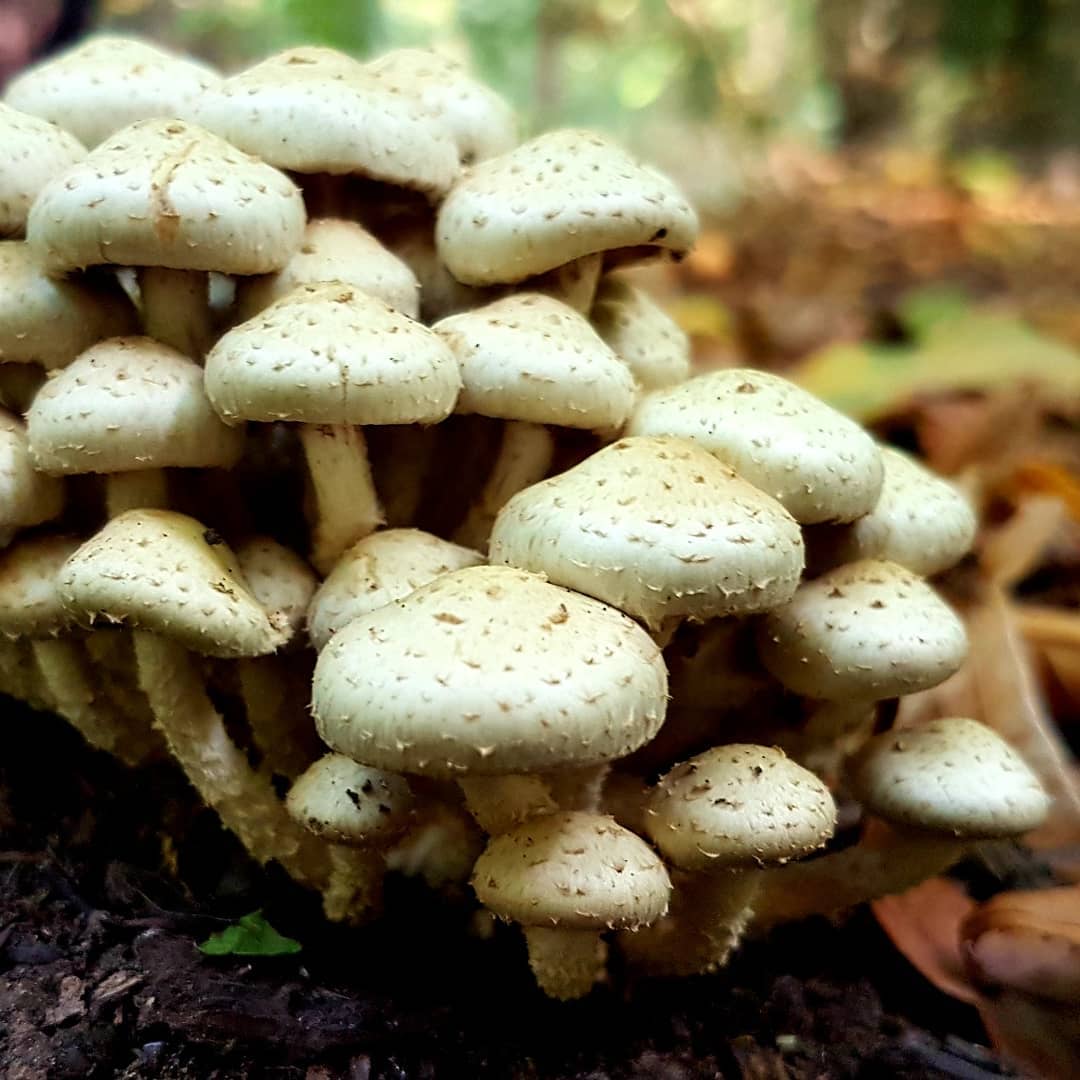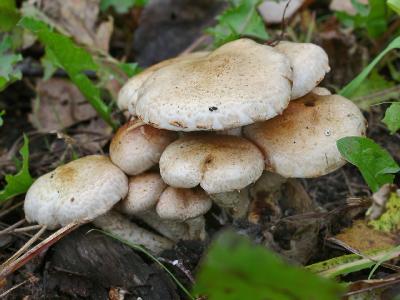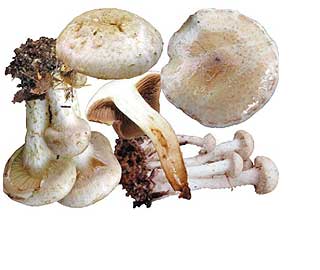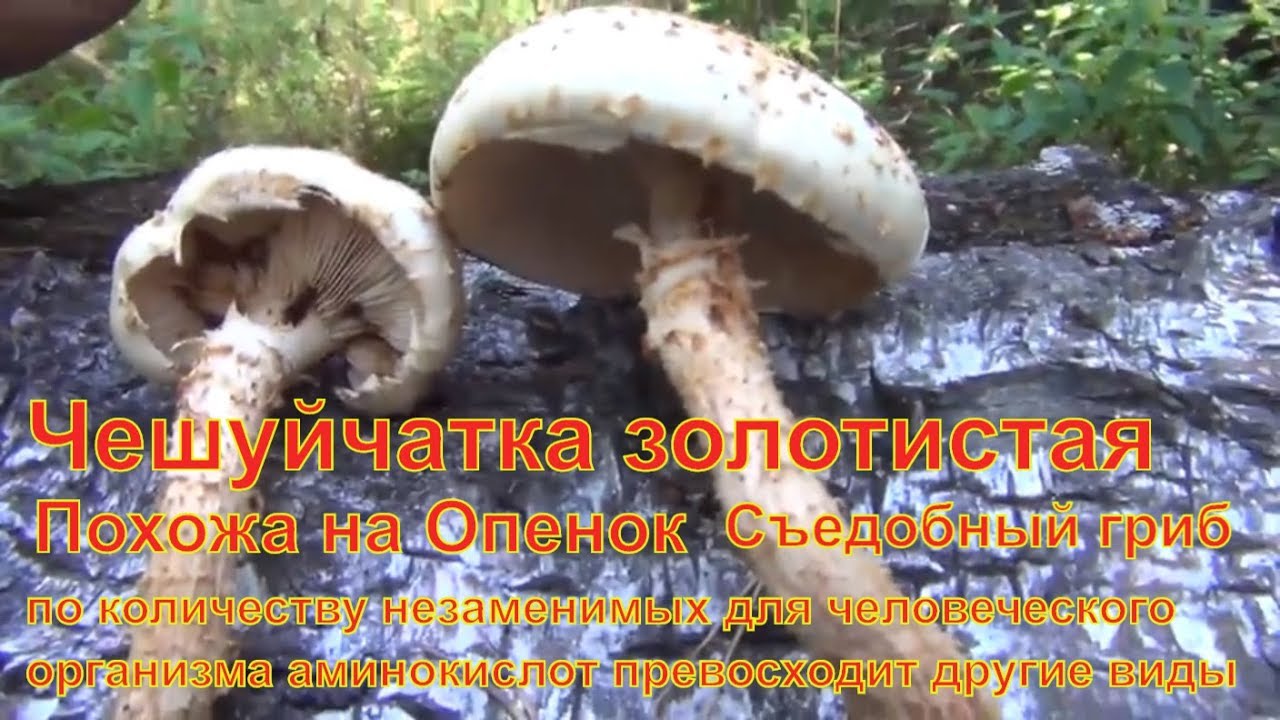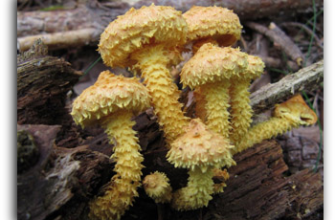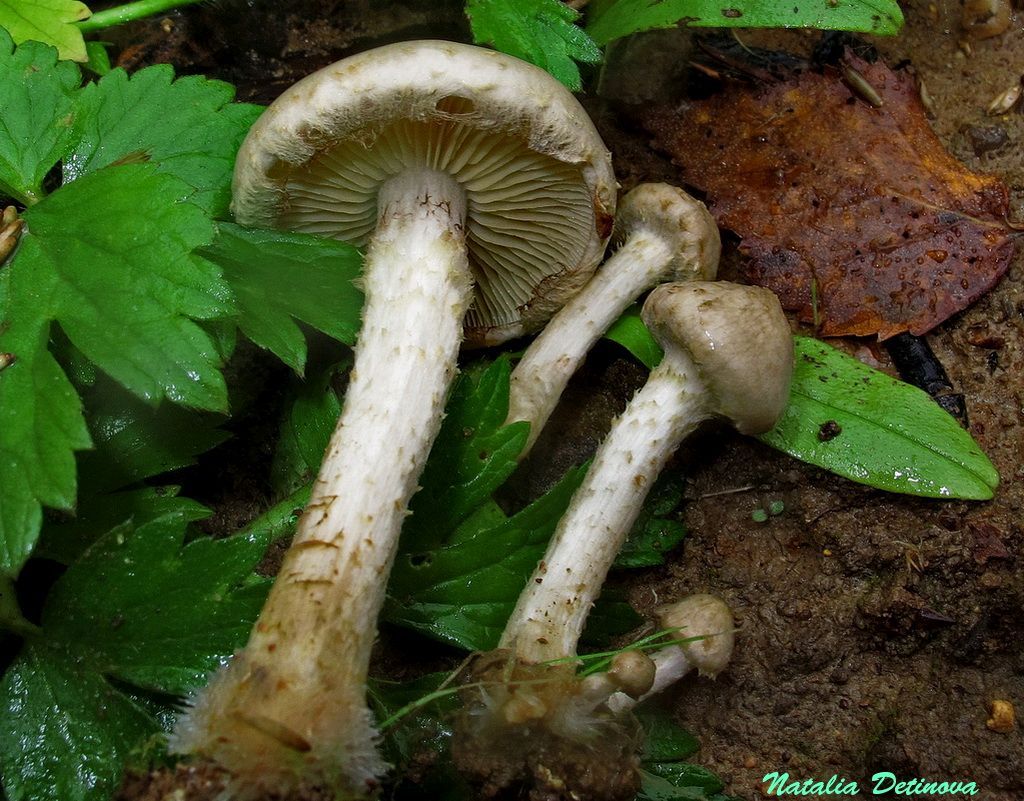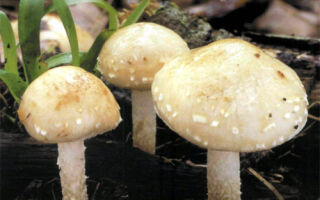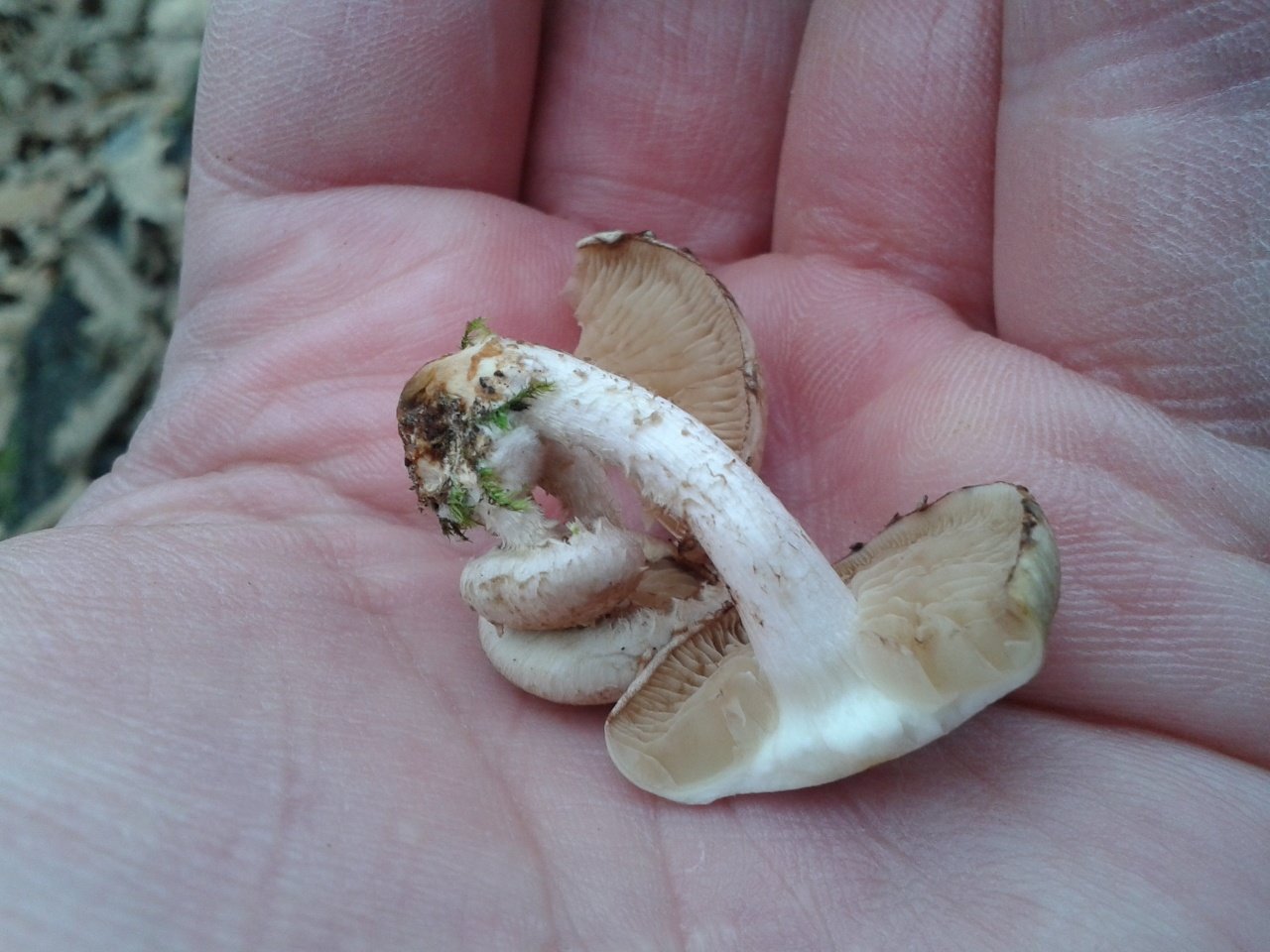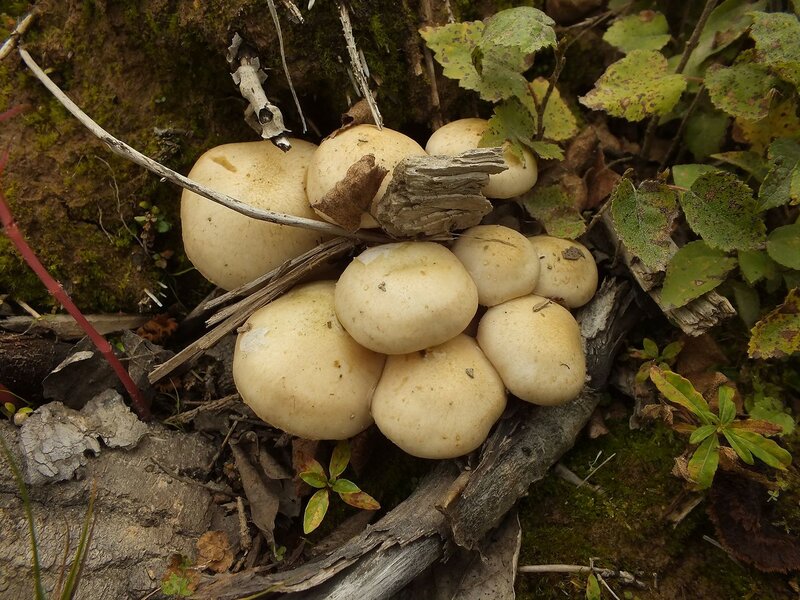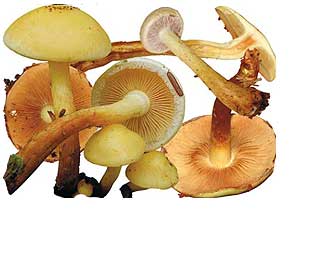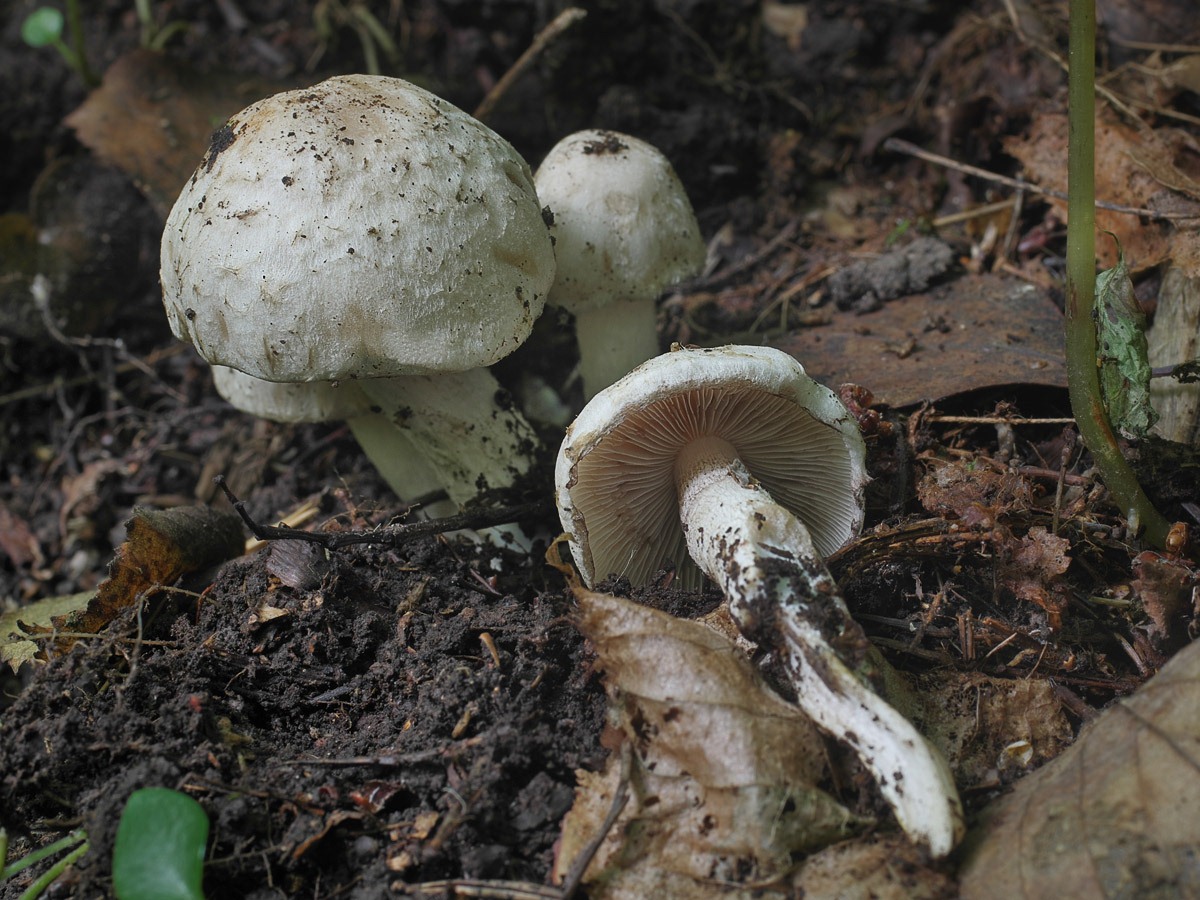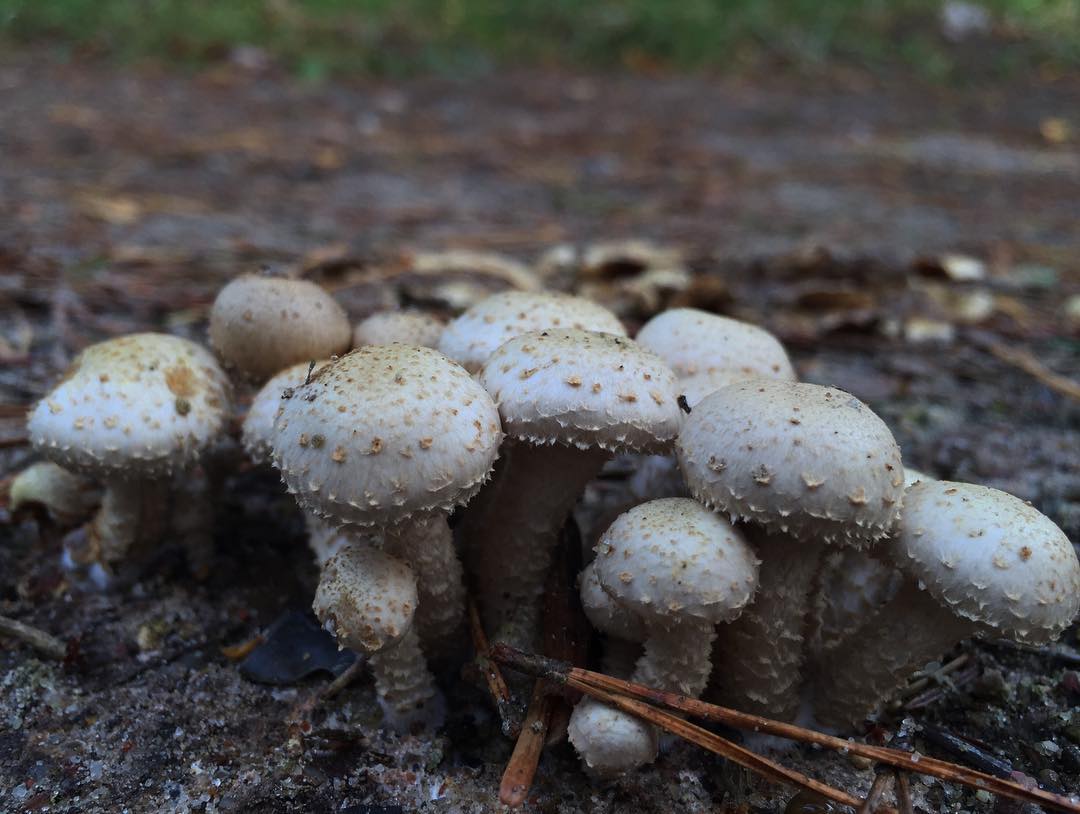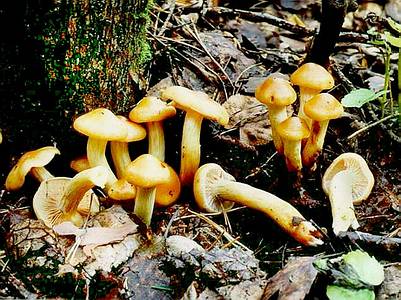Definitioner
- Basidia (Basidia)
-
Lat. Basidia. A specialized structure of sexual reproduction in fungi, inherent only in Basidiomycetes. Basidia are terminal (end) elements of hyphae of various shapes and sizes, on which spores develop exogenously (outside).
Basidia are diverse in structure and method of attachment to hyphae.
According to the position relative to the axis of the hypha, to which they are attached, three types of basidia are distinguished:
Apical basidia are formed from the terminal cell of the hypha and are located parallel to its axis.
Pleurobasidia are formed from lateral processes and are located perpendicular to the axis of the hypha, which continues to grow and can form new processes with basidia.
Subasidia are formed from a lateral process, turned perpendicular to the axis of the hypha, which, after the formation of one basidium, stops its growth.
Based on morphology:
Holobasidia - unicellular basidia, not divided by septa (see Fig. A, D.).
Phragmobasidia are divided by transverse or vertical septa, usually into four cells (see Fig. B, C).
By type of development:
Heterobasidia consists of two parts - hypobasidia and epibasidia developing from it, with or without partitions (see Fig. C, B) (see Fig. D).
Homobasidia is not divided into hypo- and epibasidia and in all cases is considered holobasidia (Fig. A).
Basidia is the place of karyogamy, meiosis and the formation of basidiospores. Homobasidia, as a rule, is not functionally divided, and meiosis follows karyogamy in it. However, basidia can be divided into probasidia - the site of karyogamy and metabasidia - the site of meiosis. Probasidium is often a dormant spore, for example in rust fungi. In such cases, probazidia grows with metabasidia, in which meiosis occurs and on which basidiospores are formed (see Fig. E).

See Karyogamy, Meiosis, Gifa.
- Pileipellis
-
Lat. Pileipellis, skin - differentiated surface layer of the cap of agaricoid basidiomycetes. The structure of the skin in most cases differs from the inner flesh of the cap and may have a different structure. The structural features of pileipellis are often used as diagnostic features in descriptions of fungi species.
According to their structure, they are divided into four main types: cutis, trichoderma, hymeniderma and epithelium.
See Agaricoid fungi, Basidiomycete, Cutis, Trichoderma, Gimeniderm, Epithelium.
- Ixokutis
-
Cutis, consisting of hyphae immersed in mucus. The surface of the cap is oily, slippery or slimy.
Lat. Ixocutis.
See Cutis, Gifa.
- Cutis
-
The type of cap skin, consists of creeping non-gelatinized hyphae located parallel to the surface. The surface of the cap looks smooth.
Lat. Cutis.
See Gifa.
Scale yellow-greenish
Scale yellow-greenish - lat. Pholiota gummosa
This mushroom from the extensive genus foliot or scaly and the Strophariev family has other names: yellow-green scaly and gum-bearing scaly.
Mushroom cap
The yellow-greenish scaly got its name for the characteristic color of the cap, which can change from light yellow to yellow with a greenish tinge. Even as babies, gum-bearing foliots looked at the world with bell-shaped "heads".
However, having matured, the mushrooms changed the shape of the cap. Now it has become prostrate with a small and darkened convex tubercle in the center. The diameter of the cap disc can vary from 3 to 6 centimeters.
The edges of the cap are slightly bent inward and on them you can clearly see felt light scraps from the hymenophore and the upper part of the leg of the private veil that once covered the hymenophore. The very surface of the cap has tiny scales, which by the time of ripening completely disappear and the skin becomes smooth and sticky.
The lamellar hymenophore is characteristic of most scales, including the gum-bearing foliota. The adherent plates of a cream or ocher color with an implicit greenish tint are densely planted.
Stipe
The main part of the leg is light yellowish with a slight green tinge. Only at the base is its color much darker and close to a rusty brownish color. A weakly expressed ring from a private bedspread, although there is, is almost invisible.
The cylindrical and very dense leg has a maximum length of 8 cm, and a minimum length of 3 cm.At the same time, the diameter of the column does not exceed 1 cm.
The surface of the leg is covered with light felt scales. The upper part is fibrous, but smooth.
Scale yellow-greenish - lat.Pholiota gummosa
Definitioner
- Basidia (Basidia)
-
Lat. Basidia. A specialized structure of sexual reproduction in fungi, inherent only in Basidiomycetes. Basidia are terminal (end) elements of hyphae of various shapes and sizes, on which spores develop exogenously (outside).
Basidia are diverse in structure and method of attachment to hyphae.
According to the position relative to the axis of the hypha, to which they are attached, three types of basidia are distinguished:
Apical basidia are formed from the terminal cell of the hypha and are located parallel to its axis.
Pleurobasidia are formed from lateral processes and are located perpendicular to the axis of the hypha, which continues to grow and can form new processes with basidia.
Subasidia are formed from a lateral process, turned perpendicular to the axis of the hypha, which, after the formation of one basidium, stops its growth.
Based on morphology:
Holobasidia - unicellular basidia, not divided by septa (see Fig. A, D.).
Phragmobasidia are divided by transverse or vertical septa, usually into four cells (see Fig. B, C).
By type of development:
Heterobasidia consists of two parts - hypobasidia and epibasidia developing from it, with or without partitions (see Fig. C, B) (see Fig. D).
Homobasidia is not divided into hypo- and epibasidia and in all cases is considered holobasidia (Fig. A).
Basidia is the place of karyogamy, meiosis and the formation of basidiospores. Homobasidia, as a rule, is not functionally divided, and meiosis follows karyogamy in it. However, basidia can be divided into probasidia - the site of karyogamy and metabasidia - the site of meiosis. Probasidium is often a dormant spore, for example in rust fungi. In such cases, probazidia grows with metabasidia, in which meiosis occurs and on which basidiospores are formed (see Fig. E).
See Karyogamy, Meiosis, Gifa.
- Pileipellis
-
Lat. Pileipellis, skin - differentiated surface layer of the cap of agaricoid basidiomycetes. The structure of the skin in most cases differs from the inner flesh of the cap and may have a different structure. The structural features of pileipellis are often used as diagnostic features in descriptions of fungi species.
According to their structure, they are divided into four main types: cutis, trichoderma, hymeniderma and epithelium.
See Agaricoid fungi, Basidiomycete, Cutis, Trichoderma, Gimeniderm, Epithelium.
- Trichoderma (Trichoderma)
-
The type of cap skin, usually consists of straight, septate elements located more or less perpendicular to the surface and laid both at the same and at different levels; the ends of the hyphae can be morphologically modified and represent dermatocystids. The surface of the cap is velvety to almost felt.
Lat. Trichoderm.
Trichoderma, in turn, is subdivided into intertwined trichoderma and irregular trichoderma.
Intertwined trichoderm (Intricate trichoderm) - trichoderm, consisting of intertwined hyphae, located not parallel to each other and forming a tomentose pubescence.
Irregular trichoderm - Trichoderma, consisting of irregularly branching hyphae.
See Dermatotsistida, Hypha, Septa.
- Cutis
-
The type of cap skin, consists of creeping non-gelatinized hyphae located parallel to the surface. The surface of the cap looks smooth.
Lat. Cutis.
See Gifa.
Gallery: varieties of scales (47 photos)
Edible flakes
Рhоl.nаmеko - a variety also known under the name Honey mushroom hint, which translates into Russian as "slippery mushroom". It grows similarly to mushrooms, in whole "families". Several rather thin legs are formed from a single base at once.
The edible variety prefers stumps and fallen tree trunks of not very common broadleaf species such as beech and hornbeam. The hat is small in size, orange-brown in color, covered with a slippery and jelly-like skin. In artificial conditions, it is cultivated in Japan and China, where it is very widely used to make the popular and healthy miso soup.

Edible flakes
Common scaly
Phol.squarrosa is a parasitic edible species that has become widespread in our country or a classic saprotroph that develops fruiting bodies on living and dead deciduous wood. It has a flat-convex, convex-conical or hemispherical cap part with turned-up edges and the remains of a bedspread. The skin is distinguished by the presence of dry, bright yellow scales, slimy type, yellow-reddish-orange coloration.
The soft part is light beige-yellow or greenish, with an unexpressed earthy aroma and rare taste. Plates of an adherent type, with a frequent location, yellowish or rusty-brown in color. The leg is whitish with a reddish-reddish-brown tint and the presence of a fibrous and sagging ring. Spores are rusty reddish brown.

Common scaly
Scaly fleecy
Рholiotа squarrоs is an edible variety, characterized by a yellow or yellowish-reddish-brown cap, with a mass of reddish-brown scales, bell-shaped or semi-open, with cap edges tucked inward. The soft part is yellowish, bitter, with the taste of garden radish and a pungent odor.
The plates are light yellowish or grayish-brownish-brown, accrete to the peduncle or slightly descending. Spores are rusty reddish brown or brownish. The leg is monophonic with a cap, with the presence of a ring, covered with scales. Fruiting from mid-August to late autumn, forming numerous fruiting bodies on stumps and on the trunk of trees.

Scaly fleecy
Scale golden
Рhol.aurivella is a variety also known as golden-yellow or gray-yellow scales, willow or royal honeydew. It has a very characteristic bright golden yellow or golden coloration of the entire fruiting body. The edible form has a large and spherical cap with a glossy surface and the presence of rare brownish scales. Most often, single fruiting bodies are formed on alder or birch stumps in damp and marshy areas.

Scale golden
Poplar scale
Pholiota destruens is a variety also known as poplar. It is distinguished by a hemispherical and fleshy, light brown cap, covered with numerous, but not too large, white scales, resembling outwardly poplar fluff. The husk on the cap is yellowish-brown in color, and the brim has whitish leathery patches hanging down.
The soft part is whitish, slightly bitter, with a characteristic malt aroma. The plates are often located, accrete with the area of the leg, whitish, brownish or tobacco-brown in color. Spores are yellow or orange. The area of the pedicle is short and thick, with a thickening and roots at the base, with a whitish or light brown surface covered with filaments and having a disappearing ring.

Poplar scale
Flame scale
Phol.flamman is an inedible variety, characterized by a bitter pulp taste and not too expressive smell.It has a hemispherical or conical, then convex and flat-convex in shape, a cap with pronounced curved edges and non-falling remnants of the veil at the edges. The topcoat is dry with very visible bright yellow scales.
The soft part is yellowish-orange or brownish, with a faint earthy odor, insipid taste, and a slight bitter aftertaste. The plates are narrowish-accrete, with a frequent arrangement, of a grayish-yellowish or brownish coloration. The stalk is dense or hollow, with a fibrous or membranous ringlet, covered with bright reddish-yellow or brown scales. The spores are yellowish-brown, oblong, inadequate.
Growing scales at home
Of all types of flakes, it is best to cultivate mushrooms with a hint, he's a flake edible, it is mucous scaly. This mushroom is very popular in Asian cooking, especially the Japanese and Chinese who grow hint on an industrial scale.
By the way, edible flakes can also be found in our retail network. Tins of canned mushrooms on the shelves of our supermarkets are very often filled with honey agarics. However, due to the fact that this mushroom is very unfamiliar to the domestic buyer, marketers prefer not to indicate the name of the canned mushroom, so as not to embarrass the timid domestic consumer.
For the cultivation of mucous flakes, substrates made on the basis of waste from the wood processing industry, as well as some types of agricultural production, are excellent. In other words, a nutrient medium for mycelium development and the appearance of fruit bodies are sawdust (primarily deciduous trees) or chopped straw, to which sunflower husks, wheat bran, chopped corn cobs, etc. are added.
The resulting substrate is sterilized by keeping at a temperature of about 100 ° C for 5 hours. For convenience and reliability, it is recommended to form small blocks from the substrate in advance, sterilizing them in this form, and not as a total mass. Then the substrate must be moistened, bringing it to 65-70% humidity.
Mycelium can be purchased either at the gardener's shop or online. The planting rate is 5% of the substrate mass. In this case, the mycelium is planted without fail under sterile conditions and at a temperature not exceeding 30 ° C.
After that, the substrate is placed in a room (or incubation chamber) with a temperature of about 27 ° C for 2-3 weeks. At this stage, the flakes do not need lighting, but the air humidity must be maintained at about 80%.
After the specified period, the substrate overgrown with mycelium is transferred to another room, where the air temperature is about 11 ° C, and the humidity is at least 98%. In this case, the substrate needs normal air exchange, so it is no longer possible to keep it in tight bags.
As soon as the first rudiments of fruiting bodies appear on the substrate, their growth should be stimulated by increasing the air temperature by an average of 5 ° C. You can also lower the humidity a little - literally by 5-10%. At this stage, you need to provide good lighting for at least 10-12 hours a day.
Having withstood the technology, you can collect mushrooms with a total mass of up to 30% of the mass of the original substrate.
There is also an alternative method that mimics the natural conditions in which the scaly fungus grows. This is solid wood. For these purposes, a stump or deck of deciduous tree is suitable. It is best to use aspen, poplar, willow, or birch. Also, some fruit trees, for example, walnut, apple, plum, show themselves well.
The mycelium must be placed in the previously made cuts in the wood. It is recommended to make simple holes with a drill, placing them at least 15 cm apart. The cuts should be about 4 cm deep and no more than 3 cm in diameter.
Some amateur mushroom pickers also practice a very unusual method - they split the log lengthwise, pour a thin layer of mycelium into the split, and then, putting the halves together, twist them tightly with wire.
Scaly mucosa: photo and description
| Name: | Scaly mucosa |
| Latin name: | Pholiota lubrica |
| Type of: | Conditionally edible |
| Specifications: |
|
| Systematics: |
|
The fungus of the family of stropharia flakes is distributed throughout the country. There are many varieties of it: slimy scaly, fiery, golden and other types.
Mushrooms are considered conditionally edible, have beneficial properties used for treatment in traditional medicine. They grow in small families on stumps, roots and in the hollows of trees (most often birches and willows).
What does scaly mucosa look like?
Externally, the scaly mucosa is similar to honey agarics, it grows in the same groups. The avid mushroom pickers of our country most often neglect this species, mistaking it for a toadstool.
In eastern countries, flake is very popular, occupies a worthy place in cooking, and is grown in artificially created conditions.
This mushroom is also called mucous champignon, flamulla, fiberglass and greenlandic scaly.
Description of the hat
In young specimens of flamulla, the mucous cap is bell-shaped with a closed edge. With growth, the cap becomes slightly concave and unfolded, reaching 50 - 100 mm in size.
The color of the cap is brown, more saturated in the center. It is covered with a matte skin, abundantly covered with scales. In damp weather, the skin becomes sticky. At the edges of the cap, you can find the remains of the blanket, washed away by the rain during the growth.
As it grows, the hat bottom is covered with weak yellow-green plates, occasionally covered with brown spots.
Leg description
The cylindrical hollow leg of a young mushroom is usually crooked, has a height of up to 10 cm, and its diameter is no more than 10 mm. As it grows, the cavity of the leg is filled with cotton pulp.
There is a yellowish ring on the leg of a young scale, which quickly disappears. The edges of the ring are red in color, and under the ring itself there are many scales.
Is the mushroom edible or not
The mucous fiber is a conditionally edible mushroom. All parts of young specimens and caps of adult mushrooms are suitable for food. During processing, the legs become very hard and tasteless, and therefore are not used in cooking.
Despite the fact that mucous flakes lack a strong mushroom aroma, they are suitable for cooking main courses and pickling. Gourmets classify the flake variety as a delicacy. Before the main stages of cooking, the mushrooms must be boiled for a quarter of an hour. Drain the water. This is how they get rid of the inherent bitterness.
The healing properties of mucous scales
Currently, the types of flake fungi have not been fully studied. Scientific studies carried out in laboratory conditions on white mice have shown that in the fibrous mucosa there are substances that can stop the growth of tumor cells.
Where and how it grows
The localization and growth method of this type of mushroom is similar to the mushrooms, which are widely known to avid mushroom pickers. Scaly scales grow on rotten, rotten wood. It settles in small families, prefers coniferous and mixed forests with a temperate climate.
In Russia, it is widespread in Karelia, the Far East, in the forests of the Urals and Siberia. Fruiting begins in late August and lasts until the first frost.
Doubles and their differences
Due to the fact that flake is little known among mushroom pickers, it is often confused with other types:
- Honey mushrooms.In contrast to the fiberglass, honey agarics have a denser ring of the leg and the plate of the cap. The color is also excellent. Honey mushrooms are considered conditionally edible and are widely used in cooking;
- Blue-bore spiderwebs (staining) are an inedible type of mushroom that grows on mosses in swampy areas. Cobwebs have a different color from flamull: ocher with a bluish tint or violet-blue color.
Conclusion
Despite the fact that slimy scales are little known, and few fans of mushroom hunting pay due attention to it, the mushroom has some advantages. With proper culinary processing, delicious dishes and blanks are obtained from it.
The medicinal properties suggest that eating and as a medicinal raw material can benefit the body.
Botanical description of flake species
The most popular and widespread species on the territory of the CIS countries are edible flakes, golden, common, cinder, and alder. Each of the presented species has individual characteristics, thanks to which they cannot be confused with other mushrooms.
Edible flakes
Edible flake has other names - hint, hint, hint foliot. The fruiting body consists of a thin low stem and a small rounded orange cap. Its surface is covered with mucus.
It grows both in the wild and under artificial conditions. It is widely used in Japanese cuisine.
Scale golden
This type of mushroom has a large cap 20 centimeters in diameter, which in young fruits has a slightly curved edge. It has a tubercle in the center. Dense in structure, the color can vary from yellow to reddish or brown. At high air humidity, the cap becomes slimy, and in dry weather it dries up and has a shiny surface.
Ripe fruits have a yellow pulp, dense in structure. The leg reaches 15 centimeters in height, dense.
Scale golden
Common scaly
Refers to conditionally edible mushrooms. It is the most widespread and popular type of mushroom among all scales. Cultivated successfully by Japanese farmers and grown for sale, grows wild in temperate climates.
For normal growth, it needs light, appears on the surface as soon as the snow melts. The season lasts until mid-autumn. Grows in rare forests with a large number of clearings (woodlands), as well as small parks. Distributed in Siberia, the Urals, Western and Eastern Europe.
Scaly fleecy
The fleecy scaly grows as a parasitic organism on dying tree trunks. It grows in small groups, and the fruiting season begins in mid-August and lasts until November. The hat is small - up to 10 centimeters in diameter, convex. The surface is covered with slightly protruding scales. The pulp is homogeneous, firm and tastes like a radish. The leg is long - it reaches 12 centimeters in height.
The mushroom belongs to the fourth category and is generally edible, but is not used in cooking due to its bitter taste.
Scaly fleecy
Poplar scale
Poplar flake has other synonyms - destructive, poplar. It parasitizes on stumps or dry tree trunks. Distributed in the European part of Russia, as well as in Siberia and the Primorsky Territory. The hat is 15 centimeters in diameter, has a brown color and is covered with white fibers. In mature fruits, they completely disappear. The leg is long.
It grows from the beginning of August to the end of September, prefers poplar, aspen, birch for growth. Inedible.
Flame scale
Fire scales have a cap diameter of about 10 centimeters, bright yellow or lemon color. In the center, the color is slightly darker, and along the edges there are large scales to match the fruit. The plates are brown, in young fruits they are covered with a small cobweb. The pulp has a pleasant aroma, slightly bitter.
It grows throughout the temperate zone of Russia at the base of deciduous trees, as well as stumps, moss.
Flame scale
Alder flakes
It grows in groups, adapting near the trunks of trees or stumps of alder, birch. The fruiting season begins in August and lasts until the end of September. The cap is small - about 5 centimeters in diameter, has brown scales with a yellow cap. The plates are beige with a yellow tint. The mushroom is inedible and can cause intoxication.
Cinder flakes
In young fruits, the cap has the shape of a hemisphere, and with ripening it opens slightly. In diameter it reaches from two to six centimeters, has a red-brown color. The surface of the fungus is slimy, with small fibrous scales.
The pulp is dense, light yellow. It has neither taste nor smell. The plates are frequent, adherent. The fruiting season starts in May and lasts until September. It grows mainly in places where fire is made.
Cinder flakes
What are scale mushrooms?
What a scaly mushroom is, a photo and a description, what medicinal properties it has, all this is of great interest to those who lead a healthy lifestyle, monitor their health, and are interested in folk methods of treatment, including with the help of mushrooms. So we will try to answer these questions in the following article.
So:
Scale, or foliota (Latin Pholiota) is a genus of mushrooms of the stropharia family. Sometimes scaly fungi are called species of mushrooms from the genus Vole, or Polevik (Agrocybe) of the Strophariaceae family.
The fruiting bodies of the cap-pedunculate with a lamellar hymenophore are of medium or large size, sometimes small, with a central or eccentric arrangement of the stem.
The cap is hemispherical or bell-shaped, opens to a slightly convex or flat-spread. The skin is usually painted in a bright color of yellow, brown or red tones, less often the color is dull. The surface is dry or slimy, may be bare, but usually with thick scales.
The pulp is fleshy, compact or relatively thin, sometimes hygrophilous, often bitter in taste.
The plates are adherent or descending, frequent, from yellowish to rusty brown or dark brown.
The stem is cylindrical, dry or slimy, the surface is scaly or smooth.
The remains of the veils: the ring on the stalk is fibrous, disappears with the growth of the fungus, forming an annular zone or is absent; scaly remnants on the cap, its edges and on the stem can be well preserved or disappear with age; Volvo is missing.
Spore powder of rusty or brown shades.

